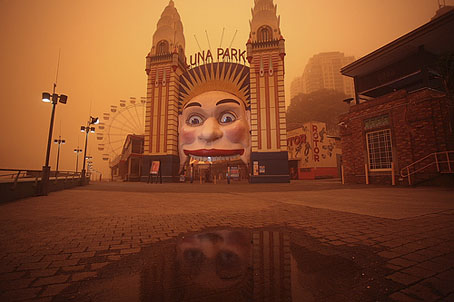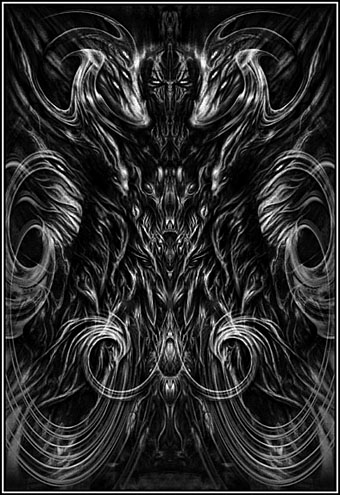The first action heroine | Ellen Ripley and Alien, 30 years on.
Category: {horror}
Horror
The coming of the dust
Impossible to avoid thoughts of either JG Ballard or various apocalyptic horror and science fiction scenarios when looking at these photos of Sydney, Australia, taken a few hours ago. A cloud of red dust passed over the city in the early morning and the depopulated views only add to the eerie atmosphere. These are from a Red Dust Flickr gallery. The Other Andrew writes about the inundation on his blog. I’m looking forward now to the reaction of another Sydney Melbourne resident, Simon Sellars, who runs Ballardian.
Update: The Red Sydney Project—Dust Storm Days
Previously on { feuilleton }
• Apocalypse now
The Thing set on survival
The Thing set on survival | Anne Billson on John Carpenter’s masterpiece.
New Modofly books
Steampunk: Life in Our New Century!
I’m behind on work updates again. Still being very productive on a range of different fronts—mostly book and CD design as usual—but the workload means that site updates tend to suffer. Anyway…
This new Steampunk illustration was a quick piece done at the weekend to accompany an article Jeff VanderMeer is writing. The collage came out better than expected considering it was pretty much slammed together in an afternoon. Coincidentally, the same weekend there was a request from Modofly for new designs to adorn their range of bespoke notebooks. The last Modofly design I produced was also a Steampunk one (depicting Jeff’s Steampunk formula) so I quickly worked this up into a new book design. I’ve also slightly reworked the Nyarlathotep design done earlier this year so it fits Modofly’s book format. When I get the time I’ll be making some Cafepress products from these designs; I’d like to see both of them as posters for a start.
Update: Jeff’s article, which includes two of my illustrations, is now posted here.
Previously on { feuilleton }
• Nyarlathotep: the Crawling Chaos
• Steampunk Redux
• Steampunk framed
• Steampunk Horror Shortcuts
New things for July
In Spaces Between from The Great Old Ones (1999).
Some noteworthy pieces of news as the month draws to a rain-sodden and dismal conclusion.
• Frank Woodward was in touch this week to let me know that his excellent HP Lovecraft documentary, Lovecraft: Fear of the Unknown, will at last be appearing on DVD in October. This is a feature-length appraisal of Lovecraft’s life, work and influence, and includes contributions from Neil Gaiman, John Carpenter, Guillermo Del Toro, Caitlin R Kiernan, Peter Straub, Ramsey Campbell and Lovecraft scholar ST Joshi. A number of my artworks are included throughout and they’ll probably also be featured in a gallery section on the disc. The film was shot in HD so it’s being released on Blu-ray as well as regular DVD.
• Also Lovecraft-related, and also due out shortly, is DM Mitchell’s follow-up to the landmark Starry Wisdom anthology of Lovecraft-inspired texts and graphics. That volume was acclaimed in some quarters and condemned in others; I don’t doubt that this new work, Songs of the Black Wurm Gism, will manage the same. Contributors include David Britton, Grant Morrison and yours truly. The cover is Alan Moore’s splendid portrait of Asmodeus.
• Last but not least, Paul Schütze was also in touch this week with news that two more audio works have been added to his online catalogue. Soundworks 01 is his atmospherics created with with Andrew Hulme from the recent TV drama series Red Riding, while Tokyo/Osaka Live is two pieces of improvisation with Simon Hopkins. Both releases are available through iTunes.




